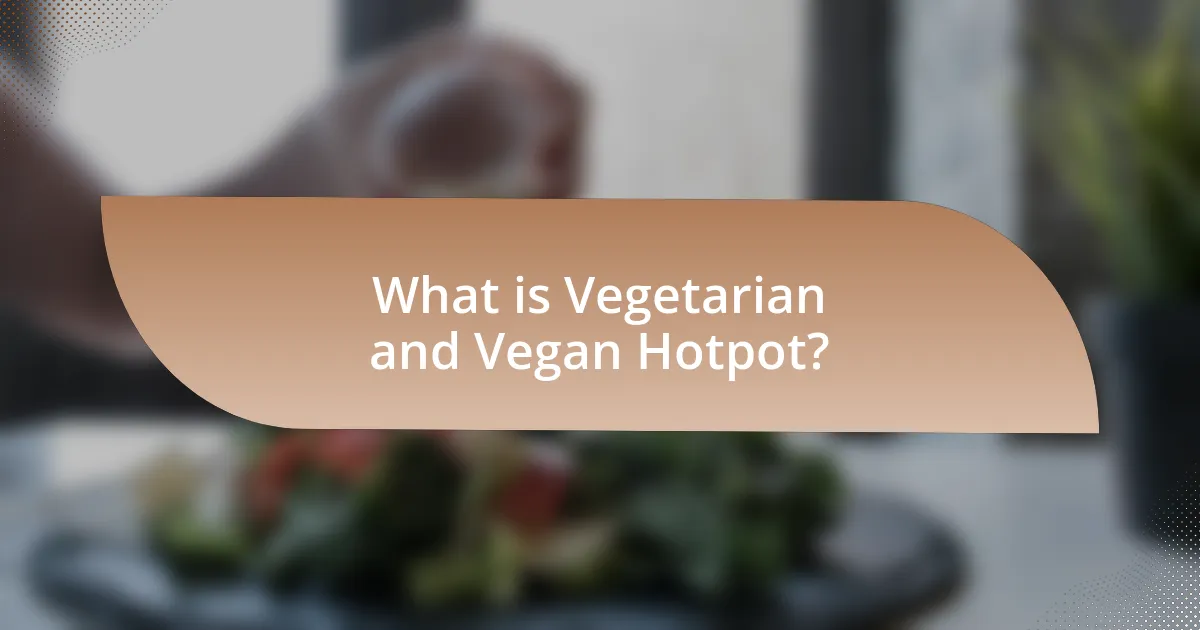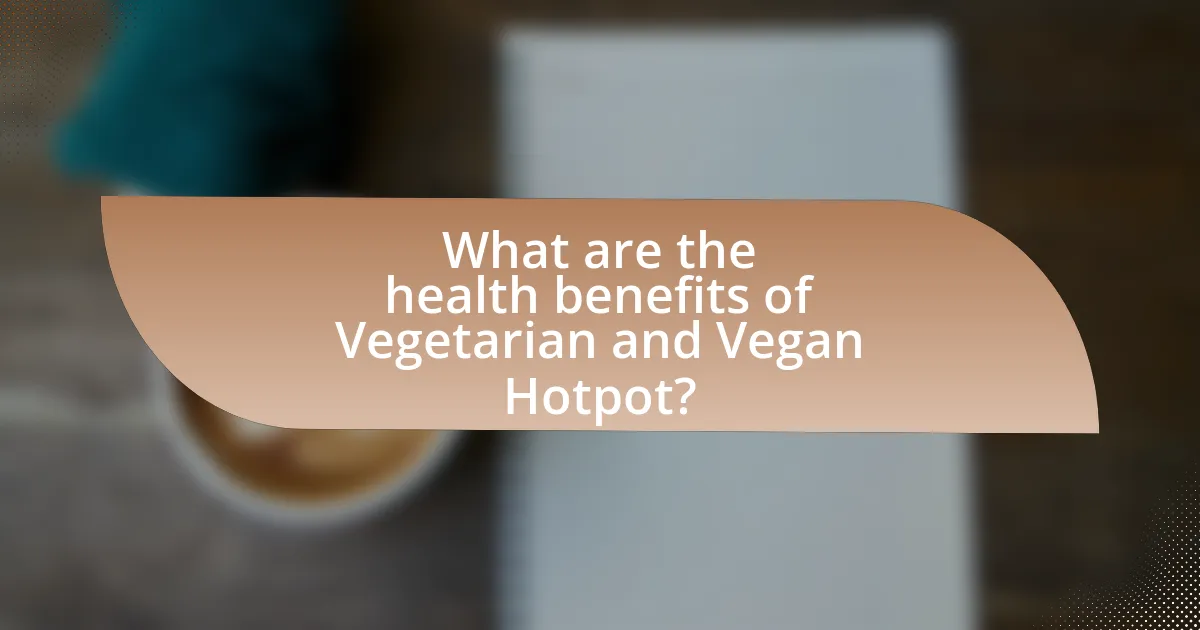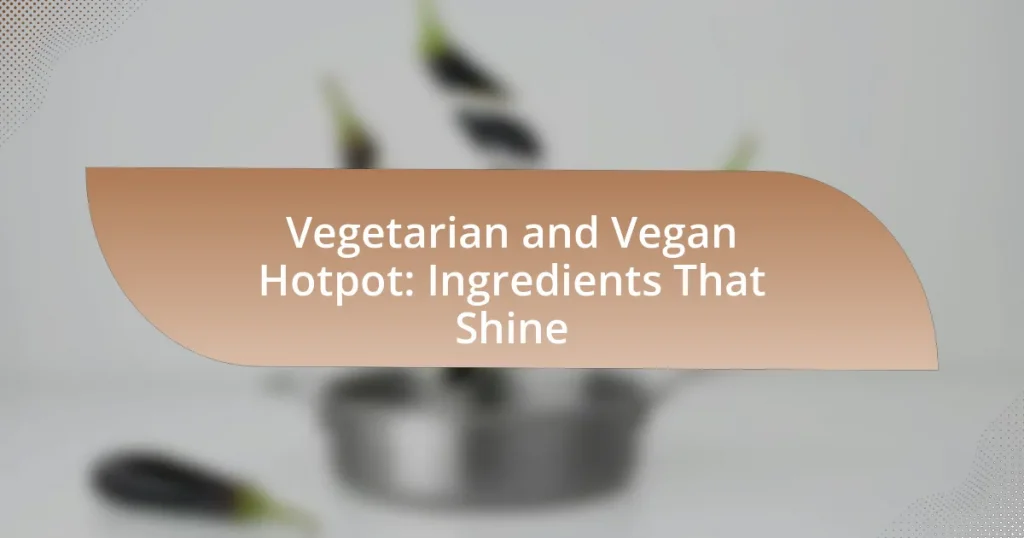Vegetarian and vegan hotpot is a communal dish centered around a simmering pot of broth where diners can cook a variety of plant-based ingredients, including fresh vegetables, tofu, mushrooms, and noodles. This culinary style, rooted in Asian traditions, caters to those avoiding animal products and promotes a sustainable dining experience. The article explores the differences between vegetarian and vegan hotpot and traditional hotpot, highlights key ingredients and broths, and discusses the health and environmental benefits associated with plant-based diets. Additionally, it provides tips for preparing flavorful hotpot, balancing flavors, and showcases popular recipes and regional variations.

What is Vegetarian and Vegan Hotpot?
Vegetarian and vegan hotpot is a communal dish that features a simmering pot of broth in which various plant-based ingredients are cooked. This culinary style emphasizes fresh vegetables, tofu, mushrooms, and noodles, allowing diners to customize their meal by selecting from a variety of ingredients to cook in the broth. The concept of hotpot has roots in Asian cuisine, particularly in Chinese culture, where it is traditionally enjoyed as a social dining experience. The vegetarian and vegan versions cater to those who avoid animal products, making it a versatile and inclusive option for diverse dietary preferences.
How does Vegetarian and Vegan Hotpot differ from traditional hotpot?
Vegetarian and vegan hotpot differs from traditional hotpot primarily in the absence of meat and animal-derived ingredients. Traditional hotpot typically includes a variety of meats, seafood, and animal-based broths, while vegetarian and vegan hotpot focuses on plant-based ingredients such as vegetables, tofu, and legumes, often using vegetable or mushroom broth as a base. This shift not only caters to dietary preferences but also promotes a more sustainable and ethical approach to dining, as evidenced by the growing popularity of plant-based diets, which have been linked to reduced environmental impact and health benefits.
What are the key characteristics of Vegetarian and Vegan Hotpot?
Vegetarian and Vegan Hotpot is characterized by its use of plant-based ingredients, which include a variety of vegetables, tofu, and mushrooms, providing a rich and diverse flavor profile. The broth is typically made from vegetable stock, infused with herbs and spices, ensuring it is free from animal products. Additionally, the hotpot allows for customization, enabling diners to select their preferred ingredients, which enhances the dining experience. This style of cooking promotes healthy eating, as it emphasizes fresh produce and minimizes processed foods. The popularity of Vegetarian and Vegan Hotpot has grown, reflecting a broader trend towards plant-based diets, supported by research indicating health benefits associated with increased vegetable consumption.
Why is Vegetarian and Vegan Hotpot gaining popularity?
Vegetarian and vegan hotpot is gaining popularity due to the increasing consumer demand for plant-based diets and healthier eating options. This trend is supported by a growing awareness of the environmental impact of meat consumption, with studies indicating that plant-based diets can significantly reduce carbon footprints. Additionally, the versatility of vegetarian and vegan hotpot allows for a wide variety of ingredients, appealing to diverse tastes and dietary preferences. The rise of social media has also contributed to its popularity, as visually appealing hotpot dishes are shared widely, attracting more people to try this communal dining experience.
What are the essential components of Vegetarian and Vegan Hotpot?
The essential components of Vegetarian and Vegan Hotpot include a variety of vegetables, plant-based proteins, and flavorful broths. Common vegetables used are mushrooms, leafy greens, carrots, and tofu, which provide texture and nutrition. Plant-based proteins such as seitan and tempeh enhance the dish’s heartiness. Broths are typically made from vegetable stock, infused with herbs and spices to create depth of flavor. These components collectively ensure a satisfying and nutritious meal that aligns with vegetarian and vegan dietary preferences.
What types of broths are suitable for Vegetarian and Vegan Hotpot?
Vegetarian and vegan hotpot can be enhanced with various broths, including vegetable broth, miso broth, and mushroom broth. Vegetable broth serves as a versatile base, made from simmering a mix of vegetables, herbs, and spices, providing a rich flavor profile. Miso broth, derived from fermented soybean paste, adds umami depth and is often combined with seaweed for additional taste. Mushroom broth, made by simmering various mushrooms, offers a hearty and earthy flavor, making it a popular choice for plant-based hotpots. These broths not only cater to vegetarian and vegan diets but also deliver robust flavors that complement the diverse ingredients typically used in hotpot dishes.
Which vegetables are best for enhancing flavor in Vegetarian and Vegan Hotpot?
Mushrooms, particularly shiitake and enoki, are the best vegetables for enhancing flavor in Vegetarian and Vegan Hotpot. Shiitake mushrooms provide a rich umami flavor due to their high levels of glutamate, which enhances the overall taste profile of the dish. Enoki mushrooms add a delicate texture and subtle sweetness, complementing the broth. Other vegetables like bok choy and napa cabbage contribute a mild sweetness and crunch, while carrots add natural sweetness and color. These vegetables not only improve flavor but also provide nutritional benefits, making them essential for a flavorful hotpot experience.
What plant-based proteins can be included in Vegetarian and Vegan Hotpot?
Plant-based proteins that can be included in Vegetarian and Vegan Hotpot are tofu, tempeh, seitan, edamame, chickpeas, lentils, and various beans such as black beans and kidney beans. Tofu is a versatile soy product rich in protein, while tempeh, also made from soy, offers a firmer texture and higher protein content. Seitan, derived from wheat gluten, is known for its meat-like texture and high protein levels. Edamame provides a complete protein source, and legumes like chickpeas and lentils contribute significant protein and fiber. Beans, including black and kidney beans, are also excellent protein sources, enhancing the nutritional profile of the hotpot.
How can one customize Vegetarian and Vegan Hotpot?
One can customize Vegetarian and Vegan Hotpot by selecting a variety of plant-based ingredients such as tofu, mushrooms, leafy greens, and a range of vegetables like bell peppers and carrots. Additionally, one can enhance the flavor profile by choosing different broths, such as miso or vegetable stock, and incorporating various sauces like soy sauce or chili paste. This customization allows for a personalized dining experience that caters to individual tastes and dietary preferences. The versatility of ingredients ensures that each hotpot can be uniquely tailored, making it suitable for diverse palates and nutritional needs.
What are some creative ingredient combinations for Vegetarian and Vegan Hotpot?
Creative ingredient combinations for Vegetarian and Vegan Hotpot include a mix of fresh vegetables, proteins, and flavorful broths. For example, combining shiitake mushrooms, bok choy, and tofu creates a rich texture and umami flavor. Additionally, using sweet potatoes, corn, and black beans adds sweetness and protein, enhancing the nutritional profile. Incorporating a variety of herbs like cilantro and basil, along with spices such as ginger and garlic, can elevate the dish’s flavor complexity. These combinations not only provide diverse tastes but also ensure a balanced meal rich in vitamins and minerals.
How can spices and sauces elevate the taste of Vegetarian and Vegan Hotpot?
Spices and sauces can significantly elevate the taste of Vegetarian and Vegan Hotpot by adding depth, complexity, and layers of flavor. For instance, spices like ginger, garlic, and chili contribute aromatic qualities and heat, enhancing the overall sensory experience. Sauces such as soy sauce, miso, or sesame oil introduce umami, which is crucial for balancing the dish, especially since plant-based ingredients often lack this flavor profile. Research indicates that umami-rich ingredients can increase overall satisfaction in meals, making them more enjoyable (source: “Umami: A New Taste Sensation,” by Ikeda, 1909). Therefore, the strategic use of spices and sauces not only enhances flavor but also improves the overall appeal of Vegetarian and Vegan Hotpot.

What are the health benefits of Vegetarian and Vegan Hotpot?
Vegetarian and vegan hotpot offers numerous health benefits, primarily due to its rich composition of plant-based ingredients. These hotpots are typically high in dietary fiber, which aids digestion and promotes gut health. Additionally, they are low in saturated fats and cholesterol, reducing the risk of heart disease. The variety of vegetables, legumes, and whole grains commonly used in vegetarian and vegan hotpots provides essential vitamins, minerals, and antioxidants that support overall health and boost the immune system. For instance, a study published in the Journal of Nutrition found that diets rich in plant-based foods are associated with lower rates of chronic diseases, including obesity and type 2 diabetes.
How does Vegetarian and Vegan Hotpot contribute to a balanced diet?
Vegetarian and vegan hotpot contributes to a balanced diet by providing a diverse array of nutrients through its variety of plant-based ingredients. These hotpots typically include vegetables, legumes, tofu, and whole grains, which are rich in vitamins, minerals, fiber, and protein. For instance, vegetables like spinach and broccoli offer essential vitamins A and C, while legumes such as lentils and chickpeas provide protein and fiber, promoting satiety and digestive health. Additionally, the inclusion of whole grains like brown rice or quinoa enhances the meal’s fiber content and provides complex carbohydrates, which are vital for energy. This combination of ingredients ensures that a vegetarian or vegan hotpot can meet the nutritional needs of individuals, supporting overall health and well-being.
What nutrients are abundant in Vegetarian and Vegan Hotpot ingredients?
Vegetarian and Vegan Hotpot ingredients are abundant in nutrients such as fiber, vitamins, minerals, and plant-based proteins. These ingredients typically include a variety of vegetables, legumes, tofu, and mushrooms, which contribute to high fiber content that aids digestion. For instance, vegetables like spinach and broccoli are rich in vitamins A, C, and K, while legumes such as lentils and chickpeas provide essential minerals like iron and magnesium. Additionally, tofu serves as a significant source of plant-based protein, offering about 10 grams of protein per 100 grams. This nutrient diversity supports overall health and well-being, making Vegetarian and Vegan Hotpot a nutritious meal option.
How can Vegetarian and Vegan Hotpot support weight management?
Vegetarian and vegan hotpot can support weight management by providing a low-calorie, nutrient-dense meal option that is rich in fiber and plant-based proteins. The inclusion of a variety of vegetables, legumes, and whole grains in hotpot recipes contributes to satiety, helping individuals feel full while consuming fewer calories. Research indicates that diets high in fruits and vegetables are associated with lower body weight and reduced risk of obesity, as they are generally lower in energy density. Additionally, the preparation method of hotpot, which often involves boiling or steaming, minimizes the need for added fats, further supporting weight management goals.
What are the environmental benefits of choosing Vegetarian and Vegan Hotpot?
Choosing Vegetarian and Vegan Hotpot significantly reduces environmental impact by lowering greenhouse gas emissions, conserving water, and preserving biodiversity. Livestock farming is responsible for approximately 14.5% of global greenhouse gas emissions, while plant-based diets contribute far less. Additionally, producing plant-based ingredients requires substantially less water; for instance, it takes about 1,800 gallons of water to produce one pound of beef compared to just 39 gallons for a pound of vegetables. Furthermore, plant-based diets help protect biodiversity by reducing the demand for land used for animal agriculture, which is a leading cause of deforestation and habitat loss. Thus, opting for Vegetarian and Vegan Hotpot supports a more sustainable and eco-friendly food system.
How does plant-based eating impact carbon footprints?
Plant-based eating significantly reduces carbon footprints by lowering greenhouse gas emissions associated with food production. Research indicates that plant-based diets can lead to a reduction of up to 50% in carbon emissions compared to diets high in animal products. This is primarily due to the fact that livestock farming is resource-intensive, requiring large amounts of land, water, and feed, which contribute to deforestation and methane emissions. A study published in the journal “Nature” by Poore and Nemecek in 2018 highlights that shifting towards plant-based diets could be one of the most effective strategies to mitigate climate change.
What role does Vegetarian and Vegan Hotpot play in sustainable eating practices?
Vegetarian and Vegan Hotpot plays a significant role in sustainable eating practices by promoting plant-based diets that reduce environmental impact. The preparation of hotpot primarily involves vegetables, legumes, and grains, which require fewer resources such as water and land compared to animal farming. Research indicates that plant-based diets can lower greenhouse gas emissions by up to 70% compared to meat-based diets, highlighting the ecological benefits of vegetarian and vegan options. Additionally, hotpot encourages the use of seasonal and local ingredients, further minimizing carbon footprints associated with food transportation.

What are some tips for preparing the perfect Vegetarian and Vegan Hotpot?
To prepare the perfect Vegetarian and Vegan Hotpot, focus on using a variety of fresh, seasonal vegetables, high-quality plant-based proteins, and flavorful broths. Incorporating ingredients like mushrooms, tofu, and leafy greens enhances the dish’s texture and nutritional value. For the broth, using vegetable stock infused with herbs and spices, such as ginger and garlic, adds depth of flavor. Additionally, ensure to include a selection of dipping sauces, such as soy sauce or sesame oil, to complement the hotpot experience. These elements create a balanced and satisfying meal that highlights the vibrant flavors of vegetarian and vegan ingredients.
How can one ensure a flavorful broth for Vegetarian and Vegan Hotpot?
To ensure a flavorful broth for Vegetarian and Vegan Hotpot, one should use a combination of umami-rich ingredients such as mushrooms, miso paste, and seaweed. These ingredients provide depth and complexity to the broth, enhancing its overall taste. For instance, shiitake mushrooms are known for their strong umami flavor, while kombu seaweed adds a natural saltiness and richness. Additionally, incorporating aromatics like garlic, ginger, and onions can elevate the broth’s flavor profile. Research indicates that umami flavors are crucial in plant-based cooking, as they help mimic the savory taste often found in meat-based broths.
What are the best practices for selecting fresh ingredients?
The best practices for selecting fresh ingredients include examining the appearance, smell, and texture of the produce. Fresh fruits and vegetables should have vibrant colors, firm textures, and a pleasant aroma, indicating ripeness and quality. For example, tomatoes should be bright red and slightly soft to the touch, while leafy greens should be crisp and free from wilting or browning. Additionally, purchasing seasonal produce enhances freshness, as it is harvested at its peak. Research shows that seasonal fruits and vegetables retain more nutrients and flavor, making them superior choices for dishes like vegetarian and vegan hotpot.
How can one effectively layer flavors in Vegetarian and Vegan Hotpot?
To effectively layer flavors in Vegetarian and Vegan Hotpot, start by using a rich broth as the base, incorporating ingredients like miso, vegetable stock, or kombu to create depth. Next, add aromatics such as garlic, ginger, and scallions early in the cooking process to infuse the broth with flavor. Layer in a variety of vegetables, such as mushrooms, leafy greens, and root vegetables, at different stages to ensure each ingredient retains its texture and contributes its unique taste. Finally, enhance the dish with sauces and condiments like soy sauce, sesame oil, or chili paste, allowing diners to customize their flavor experience. This method ensures a harmonious blend of tastes and textures, making the hotpot both satisfying and flavorful.
What common mistakes should be avoided when making Vegetarian and Vegan Hotpot?
Common mistakes to avoid when making Vegetarian and Vegan Hotpot include using insufficiently diverse ingredients, which can lead to a lack of flavor and texture. A hotpot thrives on a variety of vegetables, proteins, and broths; relying on only a few types can result in a monotonous dish. Additionally, neglecting to season the broth adequately can leave the dish bland, as the broth is the foundation of flavor. Overcooking vegetables is another mistake, as it can cause them to lose their nutrients and crispness, diminishing the overall quality of the hotpot. Lastly, failing to prepare ingredients properly, such as not slicing them uniformly, can lead to uneven cooking and an unsatisfactory eating experience.
How can overcooking affect the texture of ingredients in Vegetarian and Vegan Hotpot?
Overcooking can significantly alter the texture of ingredients in Vegetarian and Vegan Hotpot, often resulting in mushiness and loss of structural integrity. For example, vegetables like mushrooms and zucchini can become overly soft and lose their crispness, while tofu may turn spongy and less appealing. This degradation occurs because prolonged exposure to heat breaks down cell walls and denatures proteins, leading to a less desirable mouthfeel. Studies in food science indicate that optimal cooking times are crucial for maintaining the desired texture and flavor profiles of plant-based ingredients, emphasizing the importance of careful cooking in achieving a successful hotpot experience.
What should be considered when balancing flavors in Vegetarian and Vegan Hotpot?
When balancing flavors in Vegetarian and Vegan Hotpot, it is essential to consider the harmony of umami, acidity, sweetness, and spiciness. Umami can be achieved through ingredients like mushrooms, miso, or fermented products, which enhance the depth of flavor. Acidity from ingredients such as lime juice or vinegar can brighten the dish, while sweetness from vegetables like carrots or sweet potatoes can provide balance. Additionally, incorporating various spices and herbs allows for a layered flavor profile, ensuring that no single element overpowers the others. This approach is supported by culinary principles that emphasize the importance of flavor balance in creating a satisfying dish.
What are some popular recipes for Vegetarian and Vegan Hotpot?
Popular recipes for Vegetarian and Vegan Hotpot include Mushroom Hotpot, which features a variety of mushrooms like shiitake and enoki, combined with tofu and seasonal vegetables in a flavorful broth. Another popular option is the Thai Coconut Curry Hotpot, incorporating coconut milk, lemongrass, and a mix of vegetables such as bell peppers and zucchini. Additionally, the Spicy Sichuan Hotpot utilizes a base of vegetable broth infused with Sichuan peppercorns and chili oil, accompanied by ingredients like tofu, bok choy, and various mushrooms. These recipes highlight the versatility of plant-based ingredients, making them appealing for both vegetarians and vegans.
How can one create a simple yet delicious Vegetarian and Vegan Hotpot recipe?
To create a simple yet delicious Vegetarian and Vegan Hotpot, start by gathering essential ingredients such as vegetable broth, a variety of fresh vegetables (like mushrooms, bok choy, and carrots), tofu, and noodles. Combine these ingredients in a pot, bringing the vegetable broth to a simmer. Add the vegetables and tofu, cooking until tender, and then incorporate the noodles, allowing them to soften. Season with soy sauce, ginger, and garlic for enhanced flavor. This method ensures a nutritious and flavorful dish, as the combination of fresh vegetables and broth provides essential nutrients and a satisfying taste.
What unique regional variations of Vegetarian and Vegan Hotpot exist?
Unique regional variations of Vegetarian and Vegan Hotpot include the Sichuan hotpot from China, known for its spicy broth and diverse vegetable options, and the Japanese shabu-shabu, which features a lighter broth and an emphasis on fresh, seasonal vegetables. In Thailand, the tom yum hotpot offers a tangy and aromatic experience with herbs and mushrooms, while the Korean jeongol incorporates a variety of tofu and vegetables in a rich broth. Each variation reflects local ingredients and culinary traditions, showcasing the adaptability of hotpot to vegetarian and vegan diets.










